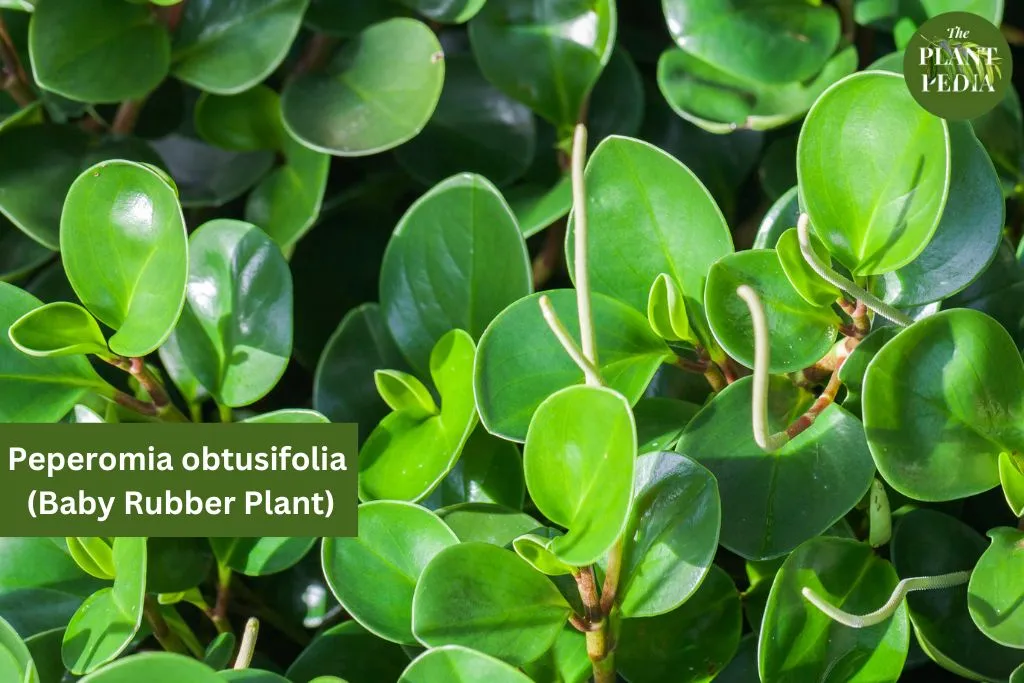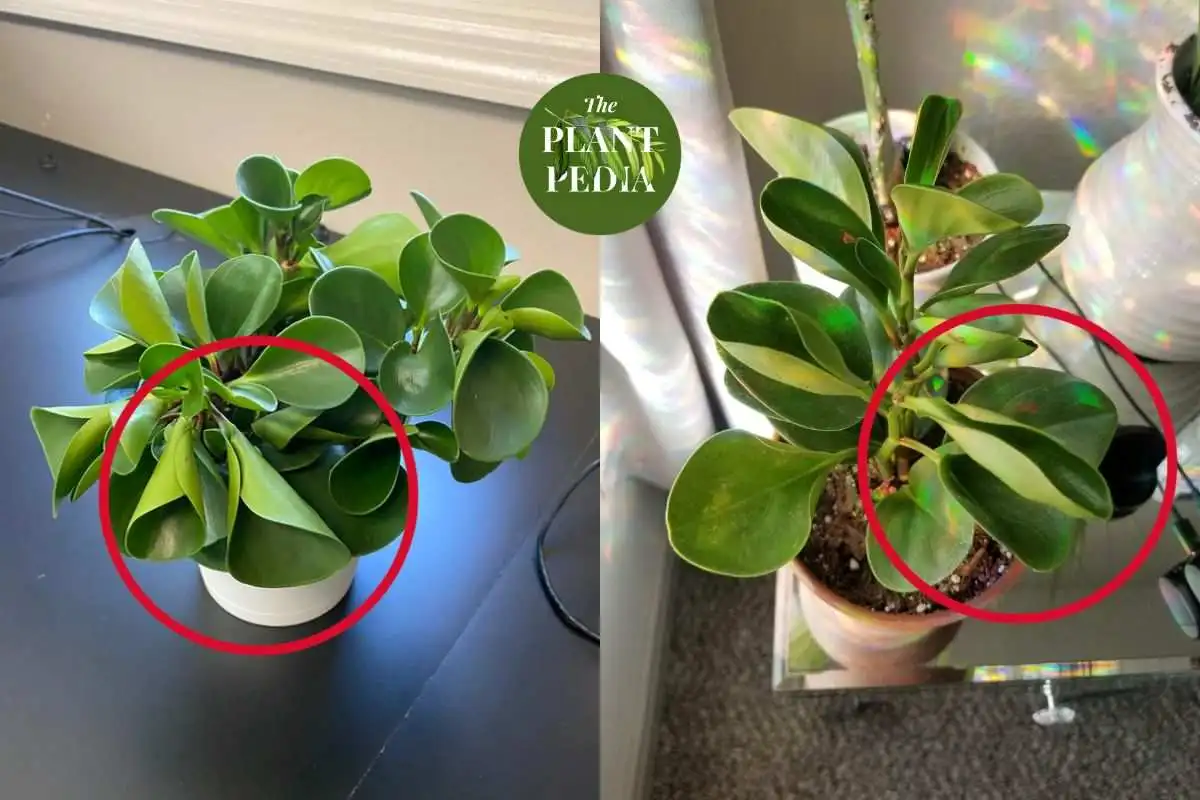Peperomia Obtusifolia, commonly known as the Baby Rubber Plant, is a beloved houseplant known for its glossy green leaves and low maintenance requirements.
However, even the most robust plants can sometimes encounter issues, and one common concern is the curling of its leaves.
If you’ve noticed this happening to your Peperomia Obtusifolia, don’t fret! In this comprehensive guide, we will delve into the potential causes behind this issue and provide actionable solutions to help your plant thrive.

Table of Contents
Introduction to Peperomia Obtusifolia
Before we delve into troubleshooting, let’s familiarize ourselves with the Peperomia obtusifolia. This plant is native to South America and belongs to the Piperaceae family.
Its thick, succulent-like leaves make it a popular choice among indoor gardeners, as it can withstand a variety of conditions.
Key Characteristics:
- Foliage: Glossy, dark green leaves, often with a hint of red or purple on the undersides.
- Size: Typically grows to a height of 8-12 inches, with a bushy, compact form.
- Light Requirements: Thrives in bright, indirect light but can tolerate lower light levels.
- Watering: Prefers slightly moist soil; avoid overwatering to prevent root rot.
- Temperature: Comfortable in average indoor temperatures, ideally between 65-75°F (18-24°C).
Peperomia Obtusifolia Leaves Curling Causes and Solutions
Leaf curling in Peperomia Obtusifolia can be attributed to various factors, ranging from environmental conditions to pests.

Here are the most common culprits:
1. Improper Watering
Improper watering is one of the most common reasons for leaf curling in Peperomia Obtusifolia. This plant is native to regions with consistent moisture levels, so it’s crucial to mimic these conditions in your indoor environment.
When the soil remains too wet for extended periods, it can lead to root rot, which in turn stresses the plant and causes its leaves to curl.
On the flip side, allowing the soil to become bone-dry for extended periods can also lead to leaf curling and general wilting.
To rectify this issue, ensure you’re using well-draining soil and a pot with drainage holes. When watering, allow the top inch of soil to dry out before thoroughly saturating the root ball.
Always empty the saucer beneath the pot to prevent water from accumulating.
2. Lighting Issues
Peperomia Obtusifolia is adapted to thrive in the dappled sunlight found beneath the canopy of larger plants in its native habitat.
When placed in direct sunlight for prolonged periods, the leaves can become scorched and start to curl.
Conversely, if the plant doesn’t receive enough light, it may start stretching towards light sources, leading to stressed, curled leaves.
Ensure your plant is situated in a spot with bright, indirect sunlight. If natural light is limited, consider using a grow light to supplement.
3. Temperature Extremes
Peperomia Obtusifolia is accustomed to a stable, tropical climate. Sudden fluctuations in temperature, such as drafts from open windows or proximity to heating or cooling vents, can lead to leaf curling.
Maintaining a consistent room temperature, ideally between 65-75°F (18-24°C), is essential for a healthy Peperomia Obtusifolia.
4. Humidity Levels
Insufficient humidity levels, particularly in dry climates or in environments with artificial heating or cooling, can cause the leaves of Peperomia obtusifolia to curl.
Misting the plant or placing it near a humidifier can help to elevate humidity levels.
Alternatively, you can create a pebble tray by placing a layer of pebbles in a saucer filled with water and setting the pot on top. As the water evaporates, it will increase the humidity around the plant.
5. Pest Infestation
Pests like spider mites and aphids are not only a nuisance but can also cause significant stress to your Peperomia Obtusifolia, resulting in leaf curling.
Regularly inspect the plant, paying close attention to the undersides of leaves and along the stems. If pests are detected, treat the plant with insecticidal soap or neem oil, making sure to follow the manufacturer’s instructions.
6. Root Bound
As Peperomia Obtusifolia grows, its roots will naturally expand and fill the pot. When this happens, the plant may become root bound, leading to stress and curled leaves.
If you notice that the roots are tightly packed and circling the inside of the pot, it’s time to consider repotting.
Choose a container that is slightly larger and ensure the new soil is well-draining to promote healthy root growth.
7. Nutrient Deficiency
A balanced nutrient profile is crucial for the overall health of your Peperomia Obtusifolia. If the plant lacks essential nutrients, it may exhibit signs like yellowing leaves, stunted growth, and, yes, leaf curling.
Regularly fertilize your plant with a water-soluble, balanced fertilizer. Be sure to follow the recommended dosage on the packaging, as over-fertilizing can lead to its own set of issues.
By addressing these potential causes, you can help your Peperomia Obtusifolia regain its vibrancy and flourish in your indoor garden. Remember, each plant is unique, so observe how your specific Peperomia responds to adjustments in care and tailor your approach accordingly.
Keep in Mind
- When watering, it’s best to water deeply and infrequently, rather than shallowly and frequently. This will help to prevent the roots from becoming waterlogged.
- When choosing a location for your Peperomia Obtusifolia, avoid placing it in direct sunlight. Filtered or indirect sunlight is best.
- If you live in a dry climate, you may need to mist your Peperomia Obtusifolia more frequently to increase the humidity levels around the plant.
- If you suspect that your Peperomia Obtusifolia is suffering from a nutrient deficiency, you can test the soil to see what nutrients are lacking. You can then fertilize the plant accordingly.
Overall, the most important thing is to pay attention to your Peperomia Obtusifolia and make adjustments to its care as needed. With a little care and attention, you can help your plant thrive.
Here are some additional tips for preventing Peperomia Obtusifolia leaf curling:
- Use a well-draining potting mix.
- Repot the plant every 2-3 years, or when it becomes rootbound.
- Fertilize the plant every 2-4 weeks during the growing season.
- Avoid overwatering or underwatering.
- Mist the plant regularly, especially during hot, dry weather.
- Place the plant in a spot with bright, indirect sunlight.
- Keep the temperature between 65-75°F (18-24°C).
- Inspect the plant regularly for pests and diseases.
By following these tips, you can help your Peperomia Obtusifolia stay healthy and prevent leaf curling.
Related FAQs:
Can I Save My Peperomia Obtusifolia If Its Leaves Are Curling?
Yes, absolutely! Curling leaves are often an indication that your Peperomia Obtusifolia is experiencing some form of stress.
By identifying and addressing the underlying issues, you can help your plant recover. Follow the steps outlined in the blog post to provide appropriate care and monitor its progress.
Is It Normal for Peperomia Obtusifolia Leaves to Curl Occasionally?
Occasional leaf curling can be normal due to factors like changes in environmental conditions or natural growth patterns. However, persistent or severe curling is a sign of stress and should be investigated further.
Should I Trim the Curling Leaves of My Peperomia Obtusifolia?
It’s generally advised to avoid trimming healthy leaves, even if they’re curled. Instead, focus on identifying and rectifying the underlying issues causing the leaf curling. Healthy leaves contribute to the overall well-being of the plant.
How Often Should I Water My Peperomia Obtusifolia to Prevent Leaf Curling?
Watering frequency depends on factors like temperature, humidity, and the type of pot and soil. As a general rule, allow the top inch of soil to dry out before watering.
Ensure proper drainage to prevent waterlogged soil, which can lead to root rot and leaf curling.
Can Direct Sunlight Cause Leaf Curling in Peperomia Obtusifolia?
Yes, direct sunlight can be too harsh for Peperomia Obtusifolia and may lead to leaf curling or even sunburn. It’s best to provide bright, indirect light for this plant.
If you’re growing it near a window, consider using sheer curtains or placing it a few feet away from the direct rays.
How Do I Check for Pest Infestations on My Peperomia Obtusifolia?
Inspect both the upper and lower surfaces of the leaves, as well as along the stems, for any signs of pests. Look for tiny webs, specks, or discolored spots.
You can also gently shake the plant over a white sheet of paper to check for any small, crawling insects.
Can I Use General Houseplant Fertilizer for My Peperomia Obtusifolia?
Yes, you can use a balanced, water-soluble houseplant fertilizer for your Peperomia Obtusifolia. However, it’s important to follow the recommended dosage on the packaging.
Over-fertilizing can lead to nutrient imbalances, which can exacerbate leaf curling.
How Do I Increase Humidity Around My Peperomia Obtusifolia?
You can increase humidity by misting the plant, placing it near a humidifier, or using a pebble tray. A pebble tray involves placing a layer of pebbles in a saucer filled with water and setting the pot on top. As the water evaporates, it increases the humidity around the plant.
When Is the Best Time to Repot My Peperomia Obtusifolia?
Spring or early summer is generally the best time to repot Peperomia Obtusifolia. This allows the plant to take advantage of the growing season.
If you notice the plant is becoming root bound or showing signs of stress, consider repotting it into a slightly larger container with fresh, well-draining soil.
How Long Does It Take for My Peperomia Obtusifolia to Recover from Leaf Curling?
The recovery time varies depending on the severity of the issue and how well you address the underlying causes.
With proper care, you can expect to see improvements within a few weeks to a couple of months. Be patient and observe your plant’s progress closely.
Conclusion
Curling leaves in your Peperomia Obtusifolia can be distressing, but armed with knowledge about potential causes and solutions, you can nurse your plant back to health.
Remember, patience and consistency are key when troubleshooting plant issues. By providing the right care, your Peperomia Obtusifolia can once again thrive and grace your indoor space with its vibrant greenery. Happy gardening!


